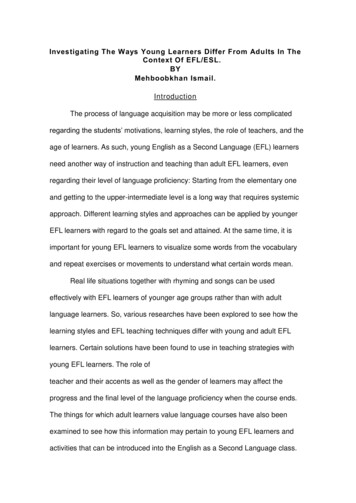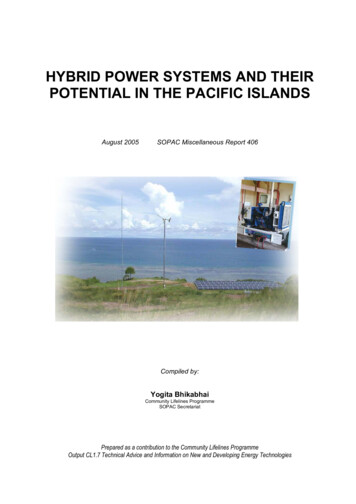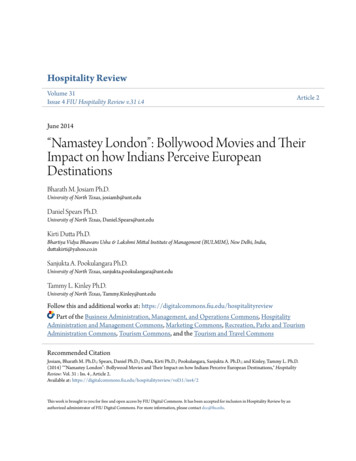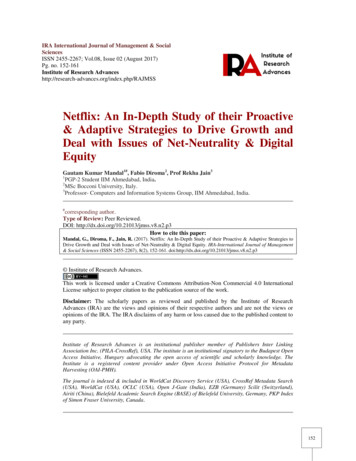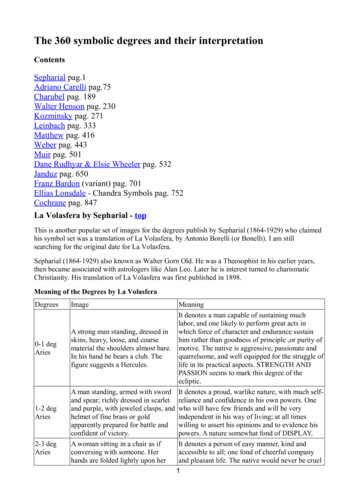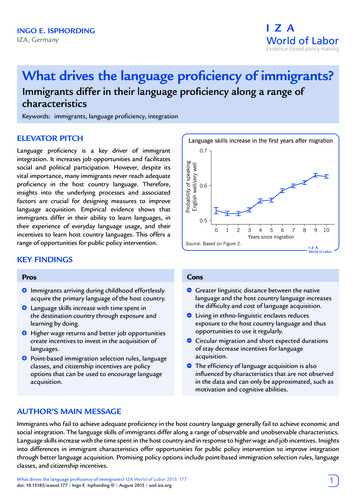
Transcription
Ingo E. IsphordingIZA, GermanyWhat drives the language proficiency of immigrants?Immigrants differ in their language proficiency along a range ofcharacteristicsKeywords: immigrants, language proficiency, integrationELEVATOR PITCH0.7Probability of speakingEnglish well/very wellLanguage proficiency is a key driver of immigrantintegration. It increases job opportunities and facilitatessocial and political participation. However, despite itsvital importance, many immigrants never reach adequateproficiency in the host country language. Therefore,insights into the underlying processes and associatedfactors are crucial for designing measures to improvelanguage acquisition. Empirical evidence shows thatimmigrants differ in their ability to learn languages, intheir experience of everyday language usage, and theirincentives to learn host country languages. This offers arange of opportunities for public policy intervention.Language skills increase in the first years after migration0.60.501234567Years since migration8910Source: Based on Figure 2.KEY FINDINGSProsImmigrants arriving during childhood effortlesslyacquire the primary language of the host country.Language skills increase with time spent inthe destination country through exposure andlearning by doing.Higher wage returns and better job opportunitiescreate incentives to invest in the acquisition oflanguages.Point-based immigration selection rules, languageclasses, and citizenship incentives are policyoptions that can be used to encourage languageacquisition.ConsGreater linguistic distance between the nativelanguage and the host country language increasesthe difficulty and cost of language acquisition.Living in ethno-linguistic enclaves reducesexposure to the host country language and thusopportunities to use it regularly.Circular migration and short expected durationsof stay decrease incentives for languageacquisition.The efficiency of language acquisition is alsoinfluenced by characteristics that are not observedin the data and can only be approximated, such asmotivation and cognitive abilities.AUTHOR’S MAIN MESSAGEImmigrants who fail to achieve adequate proficiency in the host country language generally fail to achieve economic andsocial integration. The language skills of immigrants differ along a range of observable and unobservable characteristics.Language skills increase with the time spent in the host country and in response to higher wage and job incentives. Insightsinto differences in immigrant characteristics offer opportunities for public policy intervention to improve integrationthrough better language acquisition. Promising policy options include point-based immigration selection rules, languageclasses, and citizenship incentives.What drives the language proficiency of immigrants? IZA World of Labor 2015: 177doi: 10.15185/izawol.177 Ingo E. Isphording August 2015 wol.iza.org1
Ingo E. Isphording What drives the language proficiency of immigrants?MOTIVATIONBeing able to communicate in the host country language is one of the main driversof successful economic and social integration of immigrants. Low levels of languageproficiency create high hurdles to participating in the labor market, joining in thepolitical process, and engaging in everyday social interaction. Having adequatelanguage skills allows immigrants to progress along the job ladder, increases theiremployment probability, and eases their access to better-paying jobs. Despite theimportance of language acquisition, proficiency levels remain low among largesegments of immigrant populations. Understanding the underlying processes oflanguage acquisition and the factors associated with acquiring proficiency is vital fordesigning effective policy measures to increase language acquisition and economicand social integration of immigrants. This paper surveys the empirical literature onfactors associated with language acquisition and links this evidence to potentialpolicy measures.DISCUSSION OF PROS AND CONSWhy acquiring proficiency in the host country language is importantLanguage skills are a vital part of an immigrant’s human capital. Acquiring adequateproficiency in the host country language is an important driver of immigrant economicand social integration. The importance of language proficiency for successful labormarket integration stems from at least two distinct roles of language skills.First, as the primary medium of communication, language skills are a productivetrait in themselves, and employers are willing to reward the higher productivity ofworkers who are language proficient. This wage effect of language skills combinesa direct effect of being remunerated for higher productivity and an indirect effectof having easier access to well-paid, communication-intensive jobs, thus preventingoccupational segregation.Second, language skills are complementary to the education and experience acquiredbefore migration and facilitate the transfer of these skills into the new job environment.Language skills also ease the acquisition of additional education and experience in thehost country. The influence of language skills extends beyond the economic successof immigrants. In addition to helping immigrants integrate into the labor market,language skills also crucially affect such non-market outcomes as education, health,marriage, social integration, and political participation.Despite the importance of language acquisition, proficiency levels remain low for largesegments of the immigrant population. Low language proficiency is often highlightedas a contributor to failed integration, and it can fuel anti-immigration attitudes.Nonetheless, some immigrants do gain adequate proficiency in the host countrylanguage. Thus, it is of great concern to identify the driving influences and associatedfactors behind immigrant decisions to invest in acquiring host country language skillsand understand why some immigrants learn the host country language and othersdo not.IZA World of Labor August 2015 wol.iza.org2
Ingo E. Isphording What drives the language proficiency of immigrants?Factors contributing to immigrants’ acquisition of the host country languageEconomists tend to interpret proficiency in the host country language as part of animmigrant’s human capital. As such, it is costly to acquire, inseparably connected to theindividual, and generates higher labor market returns through increased productivity.In deciding on optimal effort and commitment to acquire language skills, immigrantstrade off the expected benefits of language proficiency and the costs of acquisition.The benefits of language acquisition arise through the rewards of higher earnings,better employment probabilities, access to better jobs, and achievement of nonmarket gains through social and political participation. The costs of language skillacquisition include effort, time, the cost of language classes, and the indirect costs offorgone earnings (opportunity costs) while learning the language. Both the benefitsand the costs of language acquisition are related to observable influencing factors. Inseminal work on this issue, the determinants were classified into three groups: thoseshaping the ability and efficiency of acquiring a new language, those affecting thedegree to which immigrants are exposed to the host country language, and those thatset economic incentives for acquiring the language [1].Ability and efficiency in learning a new languageThe first group of influencing factors affects the efficiency of learning a new language.Immigrants differ in how much of an investment in resources (time, money, effort)they need to make in order to reach a certain level of language proficiency. Themost decisive factor is the age of arrival in the host country. The ability to learn newlanguages declines strongly with age. Immigrants arriving in the host country beforeadolescence almost effortlessly acquire the host country language at a proficiency levelthat equals or almost equals that of native speakers. Immigrants arriving at an olderage face greater difficulty in acquiring a new language. Linguists and neurobiologistslabel this the “critical period” hypothesis and identify a structural break in the abilityto acquire a new language in early adolescence (around the age of 11) [2].Linguistic distance—the degree of dissimilarity between two languages in vocabulary,grammar, pronunciation, and other elements of a language—is an important sourceof variation in language acquisition. The greater the linguistic distance between theimmigrant’s native language and the host country language, the higher the costsassociated with reaching a certain level of language proficiency. Various methods havebeen applied to assess the effect of linguistic distance empirically. Approaches drawfrom linguistic research on differences among languages, or they deduce linguisticdistances from the average effort of foreign language students who share a commonnative language to reach certain proficiency levels. A strong relationship betweenlinguistic distance and achieved levels of language proficiency has been documentedusing German, American [3], and Canadian microdata [2] and results on internationaltests [4].The impact of the interaction between linguistic distance and age at arrival onlanguage acquisition varies with age on arrival. Young arriving immigrants do notface additional penalties in their language acquisition as a result of greater linguisticdistance. However, for immigrants arriving after the critical period for languageacquisition, the combined impact of large linguistic distance and late arrival isIZA World of Labor August 2015 wol.iza.org3
Ingo E. Isphording What drives the language proficiency of immigrants?considerable. Evidence from international literacy test scores indicates that foreignlanguage speaking immigrants arriving at a young age have lower initial test score gapsby about half a standard deviation in literacy compared with native-language speakingimmigrants. This effect increases to about a full standard deviation for immigrantswho arrive after the critical period for language acquisition in early adolescence [3].Figure 1 depicts this relationship between linguistic distance and language proficiency(as measured by literacy scores of first-generation immigrants in the InternationalAdult Literacy Study) at young and older ages. The data are based on a sample ofimmigrants in the Czech Republic, Finland, Hungary, Italy, the Netherlands, Slovenia,Sweden, Switzerland, and the UK. The applied measure of linguistic distance isdifferences in pronunciation, as, for example, in [4]. For immigrants who arrive beforeearly adolescence literacy scores decline only modestly with increases in linguisticdifferences between their native language and the host country language. Forimmigrants who arrive after the critical period, the effect of larger linguistic distanceson language acquisition becomes significantly stronger.The efficiency of language acquisition is influenced by other characteristics in additionto age at entry and linguistic distance between native language and host countrylanguage. These other characteristics are generally not observed in available datasources and can only be approximated. Examples of these unobserved influences aremotivation and cognitive abilities. Motivation for language acquisition differs alongwith the reasons for migrating. Having migrated for security reasons, as indicatedFigure 1. Increases in linguistic distance reduce literacy scores more for older immigrantswho arrive after the “critical period” around age 11 for language acquisition280Literacy score260240220Young arrival (Age at entry 11)Late arrival (Age at entry 11)2000102030405060708090100Linguistic distanceNote: Predicted linear relationship (lines indicate 95% confidence intervals) of linguistic distance between nativelanguage and host country language and literacy scores (range 0–500) in host country language for first-generationimmigrants in the Czech Republic, Finland, Hungary, Italy, the Netherlands, Slovenia, Sweden, Switzerland, and the UK.Source: Calculations based on data from the International Adult Literacy Study. Online at: tliteracy.htm; and the Automatic Similarity Judgment Program. Online at: http://asjp.clld.org/IZA World of Labor August 2015 wol.iza.org4
Ingo E. Isphording What drives the language proficiency of immigrants?by refugee status, is generally negatively correlated with achieved levels of languageacquisition. Immigrants who have migrated for economic reasons tend to have higherlevels of proficiency.Still, this difference in motivation may mask other differences in the initial migrationdecision between refugees and economic immigrants. The ability and efficiency oflanguage acquisition are expected to rise with cognitive ability, which is typically notobserved in the data. Proxies for cognitive ability, such as individual and parentaleducational attainment, are positively correlated with achieved levels of languageproficiency. These relationships between efficiency-affecting variables and languageacquisition have been documented for a range of countries, including Canada,Germany, Israel, and the US, based on data on international test scores [1], [2], [4].Degree of exposure to the host country languageImmigrants do not necessarily learn the host country language in an organizedinstitutional setting, such as in language classes. Most immigrants acquire the hostcountry language through daily exposure and through involvement in day to dayactivities (learning by doing). Exposure to the host country language can happen bothbefore and after migration. Before migration, immigrants differ in whether—and howwell—they learned the host country language in school or in adult language classes inthe home country.Many countries have specialized institutions to promote their culture and language
the difficulty and cost of language acquisition. Living in ethno-linguistic enclaves reduces exposure to the host country language and thus opportunities to use it regularly. Circular migration and short expected durations of stay decrease incentives for language acquisition. The efficiency of language acquisition is also influenced by characteristics that are not observed in the data and can .
